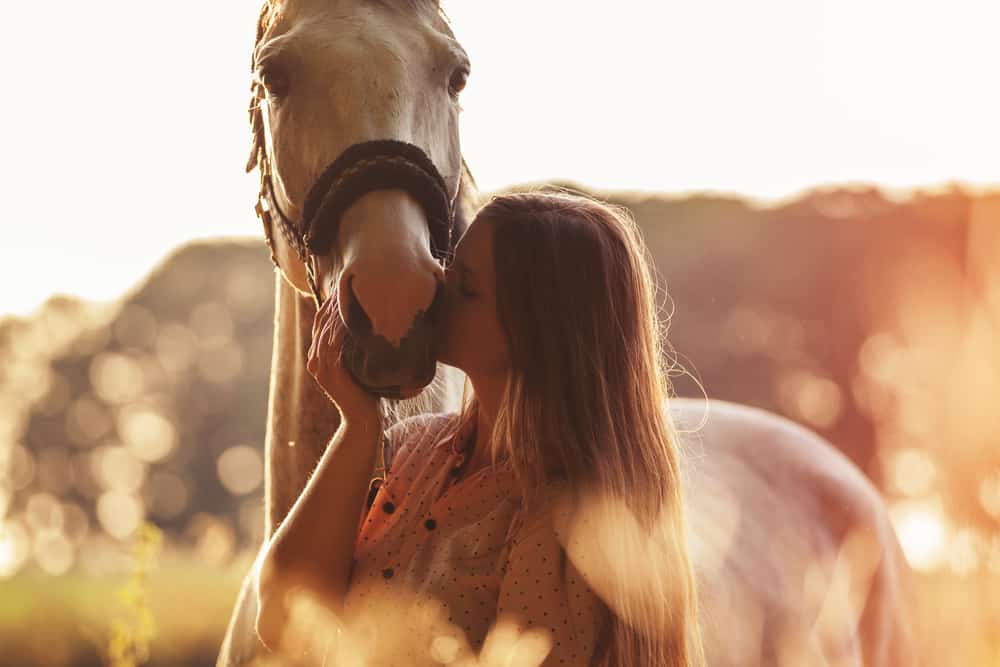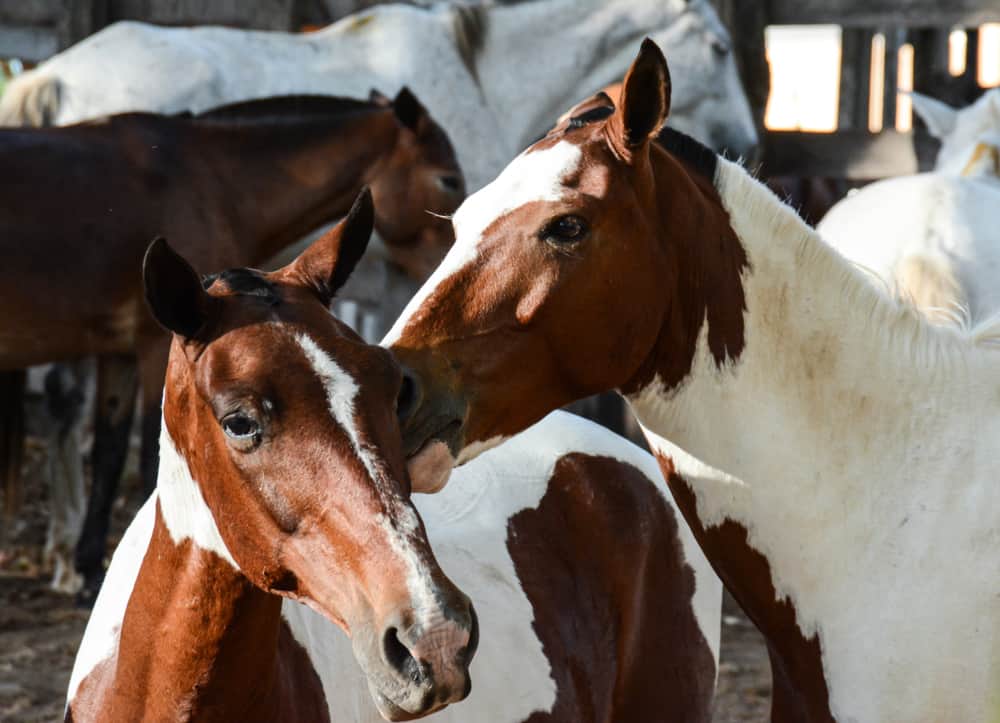- Your source for stall mats, rubber arena footing, arena harrows and arena dust control.

Horses are social beings who rely on body language and physical touch to communicate with each other and people. Most horses, especially youngsters, will attempt to interact with people in the same way that they would interact with other horses in their social group, making physical contact such as nudging and even nipping a common occurrence.
A horse will nudge you for many reasons; to express curiosity in something you are doing or holding, ask for affection, beg for a treat, or display displeasure in a particular situation. Perhaps he has an itch to scratch and thinks you make a convenient scratching post. Either way, nudging is a form of communication, and it’s up to the handler to read into the horse’s behavior.
Many horses are brought up surrounded by people, and because of this, they may tend to see and treat people as part of their ‘herd’. Suppose your horse is trying to send you a message and feels you are not getting the picture. In that case, he will likely try a different tactic in the hopes of a better outcome, so it’s wise to learn the horse’s language to understand him better and prevent him from trying a stronger approach or from giving up on communicating with you altogether.
What is nudging?
Nudging is when a horse rubs, bumps, or pushes against you with his muzzle or head. This can range from a gentle, affectionate nuzzle to a full-blown knock-you-off-your-feet head-butt. Nudging is purely a form of communication the horse uses to get your attention, tell you something, or ask you for something. Either way, he is attempting to satisfy a want or need, using the only language he knows.
Why do horses learn to nudge?
Nudging is a learned behavior. Foals and young horses are incredibly tactile, and, just like human babies and children, they spend their early years exploring and learning about the world (and the people) around them through touch and play.
It may be cute when they’re little, I mean, who can resist an inquisitive and curious foal, poking their little nose into your pockets and nuzzling around you asking for treats or a head rub, but one day they will not be so little anymore.
The behavior which has been allowed and maybe even encouraged until this point is suddenly not so cute and will require discouragement and even reprimand. Understandably they won’t understand why this is not allowed anymore. This learned behavior is not easy to change once it becomes a habit.
As adults, horses continue to explore their world. As they interact with the people around them, they may find that certain behaviors with certain people yield certain responses or rewards, just as some behaviors result in punishment. They will realize that their dinner seems to come a little quicker if they nicker and nudge this person at mealtimes.

What is my horse saying?
Recent European studies have shown that horses do talk to humans (in their way). They can process information and knowledge that they learn through interacting with other horses and people and use it to make problem-solving decisions such as figuring out how to get what they want from their humans and have their needs met. So, what exactly are they trying to say when they nudge you?
Curiosity
Sometimes the horse just wants to see something you have or observe something you’re doing.
- “Hey, human. What have you got there?”
- “May I investigate this tool in your hand before you start rubbing it all over me?”
Inquiring
The horse could be begging for a treat or trying to have his dinner delivered post-haste.
- “Do you see that bucket over there, yes that one, the one full of my dinner… won’t you bring it over?”
- “I know you have carrots in your pocket, and I want them.”
Demanding
When nudging is taken to a whole new level, the horse displays disrespectful, dominant, and rude behavior.
- “My face is itchy; I want to rub it against you because you’re so soft, and it feels so good, and I don’t care if it hurts you.”
- “Get away from me, you’re annoying me.”
- “I’m warning you that I am unhappy, and if the situation doesn’t change, I am going to take more drastic measures to either get my message across or to fix the situation.”
When you are trying to understand your horse’s behavior and what he is trying to tell you, it is a good idea to take the time to simply observe him. Pay attention to certain possible triggers. Below are a few questions that could help you get to the bottom of it.
- When does the horse nudge? He may try to get your attention at mealtimes, urging you to hurry up and give him his dinner. He may be asking for a gentle ear rub at the end of a grooming session when he feels relaxed. He may be objecting to you putting the saddle on or bringing your attention to something that is causing him to feel uncomfortable.
- How does the horse nudge? He could give you a gentle tap on the arm or a nuzzle in your hand, a firm bump against your stomach, or perhaps he has resorted to more aggressive and threatening behavior.
- What is the result of his nudging? If a horse is nudging for a treat, and you oblige and give the horse a treat, he has essentially been rewarded for this behavior. He will continue to do it, possibly becoming more and more pushy and even dangerous over time if the behavior is not correctly addressed. Pay close attention to how you react to his behavior.
Is it ok for a horse to nudge you?
Nudging is greatly discouraged and with good reason. A horse is far larger and stronger than a human, and their faces are pretty hard and boney. They can easily cause you serious harm and even knock you right off your feet.
What may start as a gentle tap can easily escalate into something stronger and more aggressive over a short amount of time. Horses should never be allowed to push people around, demand treats, or rub and scratch their faces on them. It is highly disrespectful and can quickly become dangerous, especially when the nudge (or head-butt) recipient is caught off-guard or is a small child.
So many times, people allow such behavior because it seems harmless or even cute without considering the consequences of not addressing the issue when it first starts happening. By the time they realize that the horse’s behavior is becoming unsafe, it’s a little too late to fix it with gentle discouragement, and more drastic measures need to be taken. Inevitably this causes tension and hard feelings between horse and human.
The horse is not entirely to blame for this vice, as it might have been easily avoided had it been addressed early on. If the handlers have allowed the horse to nudge and push them around for some time without consequence, or have even rewarded the behavior by obliging him with treats or scratches, then they have led the horse to believe it is perfectly acceptable.
Before reprimanding the horse for his behavior, it is important to understand why he is doing it. There may be an underlying cause that needs to be addressed.
For example, maybe his saddle does not fit, causing him to associate it with discomfort or pain, and therefore he does not want the saddle on his back. He may start to lash out when it is brought over to him or when the girth is tightened.
Conclusion
Horses have all sorts of reasons for nudging people. Whether it is inquisitive, affectionate, or aggressive, it is the handlers’ job to learn the horse’s language and read into each situation, and understand each horse as an individual. People must always pay attention to how they act and react to the horses they work with.
If they are attentive to the horse and understand his communication, the horse will be far less likely to resort to more aggressive forms of communication.
Conversely, if a horse is disrespectful and nasty by shoving at people simply because he is impatient, this needs to be addressed swiftly and appropriately.
While it is widely agreed that nudging should be discouraged, one cannot say that nudging is all bad. Some horses have a close bond with their human, and a gentle and delicate nudge or rub is simply a sign of affection and love.

